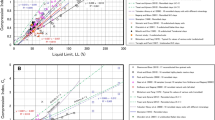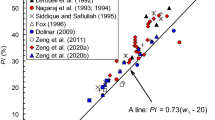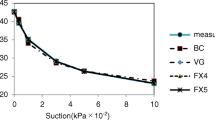Abstract
It is proposed to present compaction relationships by plotting the inverse of the dry density versus the molding water content. In the proposed graph, the curves for equal degree of saturation become straight lines. The proposed new graph is shown to be very convenient to assess the saturated hydraulic conductivity, k sat, of non-swelling compacted clay, using a dual porosity model. The value of k sat depends on the secondary porosity between clay clods. The equation developed for equal k sat value appears also as a straight line in the proposed graph. It facilitates the prediction of k sat from field compaction data and thus the prediction of field performance of clay liners and covers.
Résumé
Pour présenter les relations de compactage, on propose de porter l’inverse de la masse volumique sèche versus la teneur en eau. Dans le graphe proposé, les courbes d’égal degré de saturation deviennent des droites. Le nouveau graphe proposé s’avère très utile pour évaluer la conductivité hydraulique saturée, k sat, d’une argile compactée non gonflante, à partir d’un modèle de double porosité. La valeur de k sat dépend de la porosité secondaire entre les mottes d’argile. L’équation d’iso valeurs de k sat développée apparaît aussi comme une droite dans le graphique proposé. Ceci facilite la prédiction de k sat à partir des données de compactage de chantier, et donc la prédiction de la performance en place des tapis et couvertures en argile.





Similar content being viewed by others
Explore related subjects
Discover the latest articles and news from researchers in related subjects, suggested using machine learning.References
Arquié G (1964) L’eau et la route: terrassements, compactage, portance. Revue générale des routes et des aérodromes 391:75–81
Aubertin M, Dagenais A-M (2000) Étude des effets du gel sur les propriétés d’un matériau argileux dans une couverture. Rapport CDT P2380, École Polytechnique, Montréal
Benson C, Othman M (1993) Hydraulic conductivity of compacted clay frozen and thawed in situ. ASCE J Geotech Eng 119(2):276–294
Benson CH, Zhai H, Wang X (1994) Estimating hydraulic conductivity of compacted clay liners. ASCE J Geotech Eng 120(2):366–387
Benson CH, Daniel DE, Boutwell G (1999) Field performance of compacted clay liners. ASCE J Geotech Geoenviron Eng 125(5):390–403
Biarez J (1972) Unpublished course notes (in French). Institut de mécanique de Grenoble, France
Blotz LR, Benson CH, Boutwell GP (1998) Estimating optimum water content and maximum dry unit weight for compacted clays. ASCE J Geotech Geoenviron Eng 124(9):907–912
Boynton SS, Daniel DE (1985) Hydraulic conductivity tests on compacted clay. ASCE J Geotech Eng 111(4):465–478
Cazaux D, Didier G (2002) Comparison between various field and laboratory measurements of the hydraulic conductivity of three clay liners. In: Sara MN, Everett LG (eds) Evaluation and remediation of low and dual porosity environments, STP 1415. ASTM International, West Conshohocken, pp 3–24
Chamberlain E, Gow AJ (1979) Effects of freezing and thawing on the permeability and structure of soils. Eng Geol 13:73–92
Chapuis RP (1981) Permeability testing of soil–bentonite mixtures. Proceedings of the 10th international conference on soil mechanics and foundation engineering, vol. 4, Stockholm, pp. 744–745
Chapuis RP (1990) Sand–bentonite liners: predicting permeability from laboratory tests. Can Geotech J 27(1):47–57
Chapuis RP (2002) The 2000 R.M. Hardy lecture: full-scale hydraulic performance of soil–bentonite and compacted clay liners. Can Geotech J 39(2):417–439
Chapuis RP (2004) Permeability tests in rigid-wall permeameters: determining the degree of saturation, its evolution and influence on test results. Geotech Test J 27(3):304–313
Chapuis RP, Baass K, Davenne L (1989) Granular soils in rigid-wall permeameters: method for determining the degree of saturation. Can Geotech J 26(1):71–79
Chapuis RP, Lavoie J, Girard D (1992) Design, construction, performance and repairs of the soil–bentonite liners of two lagoons. Can Geotech J 29(5):638–649
Daniel DE (1984) Predicting hydraulic conductivity of clay liners. ASCE J Geotech Eng 110(2):285–300
Daniel DE (1985) Predicting hydraulic conductivity of clay liners: reply. ASCE J Geotech Eng 111(12):1466–1467
Daniel DE, Benson CH (1990) Water content-density criteria for compacted soil liners. ASCE J Geotech Eng 116(12):1811–1830
Day SR, Daniel DE (1985) Hydraulic conductivity of two prototype clay liners. ASCE J Geotech Eng 111(8):957–970
Delage P, Tessier D, Marcel-Audiguier M (1982) Use of the cryoscan apparatus for observation of freeze-fractured planes of a sensitive clay in scanning electron microscopy. Can Geotech J 19:111–114
Eigenbrod KD (1996) Effects of cyclic freezing and thawing on volume changes and permeabilities of soft fine-grained soils. Can Geotech J 33:529–537
Elsbury BR, Daniel DE, Straders GA, Anderson DC (1990) Lessons learned from compacted clay liner. ASCE J Geotech Eng 116(11):1641–1660
Faure AG, Da Mata JDV (1994) Penetration resistance value along compaction curves. ASCE J Geotech Eng 20:46–59
Fredlund DG, Morgenstern NR (1977) Stress state variables for unsaturated soils. ASCE J Geotech Eng 103:447–464
Granger M (1969) Méthode rapide de contrôle du compactage des sols fins. Bulletin de Liaison des Laboratoires Routiers des Ponts et Chaussées 40:43–48
Guyonnet D, Gourry J-C, Bertrand L, Amraoui N (2003) Heterogeneity detection in an experimental clay liner. Can Geotech J 40(1):149–160
Haug MD, Wong LC (1992) Impact of molding water content on hydraulic conductivity of compacted soil–bentonite. Can Geotech J 29(2):253–262
Kodikara JK, Rahman F (2002) Moisture content and hydraulic conductivity relations for compacted clay liners. Aust Civ Eng Trans 43:13–18
Lambe TW (1958) The structure of compacted clay. ASCE J Soil Mech Found Div 84(SM2):1654-1–1654-34
Langfelder LJ, Chen CF, Justice JA (1968) Air permeability of compacted cohesive soils. ASCE J Soil Mech Found Div 94(SM4):981–1001
Leflaive E, Schaeffner M (1980) Compactabilité des sols appréciée par la mesure de leur perméabilité à l’air. Proceedings of the international conference on compaction, vol. 1. Éditions Anciens ENPC, Paris, pp 57–62
Leroueil S, LeBihan JP, Bouchard R (1992) Remarks on the design of clay liners used in lagoons as hydraulic barriers. Can Geotech J 29(3):512–515
Mitchell JK, Hooper DR, Campanella RG (1965) Permeability of compacted clay. ASCE J Soil Mech Found Div 91(SM4):41–65
Mundell JA, Bailey B (1985) The design and testing of a compacted clay barrier layer to limit percolation through landfill covers. In: Hydraulic barriers in soils and rocks, STP 874. ASTM, Philadelphia, pp 246–262
Othman M, Benson C, Chamberlain E, Zimmie T (1995) Laboratory testing to evaluate changes in hydraulic conductivity of compacted clays caused by freeze-thaw: state-of-the-art. In: Daniel DE, Trautwein S (eds) Hydraulic conductivity and waste contaminant transport in soils, STP 1142. ASTM International, West Conshohocken, pp 227–254
Popovic M, Sarac D (1980) Some properties of compacted clay materials. Proceedings of the international conference on compaction, vol. 1. Editions Anciens ENPC, Paris, pp 189–193
Sherwood PT (1975) Reproductibilité des essais de classification et de compactage des sols. Bulletin de Liaison des Laboratoires Routiers des Ponts et Chaussées. No. Spécial X:145–161
Stewart JP, Nolan TW (1987) Infiltration testing for hydraulic conductivity of soil liners. Geotech Test J 10(2):41–50
Terzaghi K (1922) Der Grundbruch an Stauwerken and seine Verhaltung. Die Wasserkraft 17(24):445–449
Zimmie TF (1992) Freeze-thaw effects on the permeability of compacted clay liners and covers. Geotech News 10(1):28–30
Acknowledgments
The research results presented here were sponsored by the National Research Council of Canada. The authors thank Richard Darling for reading and commenting the manuscript.
Author information
Authors and Affiliations
Corresponding author
Rights and permissions
About this article
Cite this article
Chapuis, R.P., Mbonimpa, M., Dagenais, AM. et al. A linear graphical method to predict the effect of compaction on the hydraulic conductivity of clay liners and covers. Bull Eng Geol Environ 65, 93–98 (2006). https://doi.org/10.1007/s10064-005-0031-0
Received:
Accepted:
Published:
Issue Date:
DOI: https://doi.org/10.1007/s10064-005-0031-0




